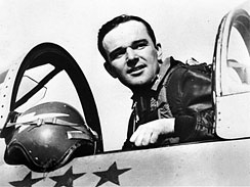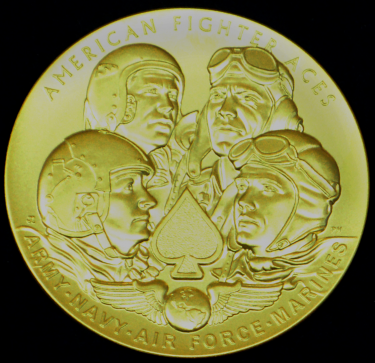
 |
|
|
||
|
Walker Melville Mahurin 'Bud' |
||||
|
Engagements: • World War II (1941 - 1945)• Korean War (1950 - 1953) |
||||
| Biography: | ||||
|
Walker Melville Mahurin Walker Melville Mahurin was born on 5 December 1918 in Benton Harbor, MI. He studied engineering at Purdue University in Indiana, but left on 29 September 1941 to enlist in the U.S. Army Air Corps' Aviation Cadet Program. After completing flight training on 29 April 1942, he was commissioned as a Second Lieutenant with the rating of Pilot. In July 1942, 1LT Mahurin was assigned to the 56th Fighter Group, which was deployed to England in January 1943. There he was promoted to Captain and named Flight Leader of the 63rd Fighter Squadron, flying the P47-Thunderbolt Fighter. CPT Mahurin's career could have ended early because he lost his P-47 Thunderbolt fighter on a mission in August 1943. While 'showing off' he flew too close under a B-24 Liberator bomber he was escorting and the bomber's propellers sheared the tail of his P-47, and he had to bail out. The B-24 was forced to make an emergency landing. However, due to his extraordinary flying skills, the brass let him off with a fine. Days later, while flying his replacement P-47 "The Spirit of Atlantic City," CPT Mahurin scored his first 2 aerial combat kills. He made Ace (5 kills) when he shot down 3 Messerschmitt BF110s on a raid on 4 October. Mahurin had his best mission on 26 November, shooting down 3 Bf 110s, presumably shooting down a 3rr, and damaging a 4th to become the first American pilot in the European Theater of Operations to score 10 aerial victories. Mahurin scored two more victories in another P-47D on 29 November 1943. CPT Mahurin became the first American pilot Double Ace in the European Theater. On 8 March 1944, he destroyed 3 Fw 190s and, on 21 March, was promoted to Major. He eventually went on to score 19.75 confirmed victories in combat in Europe, with 3 more enemy planes probably destroyed, and one damaged, before being shot down himself. On 27 March, his P-47 was heavily damaged by a German Dornier Do 217 bomber that he helped shoot down, forcing him to bail out. He parachuted to safety, hid in a farmer's haystack, and was picked up by French Resistance forces. On the night of 3–4 May 1944, an RAF Westland Lysander attempted to retrieve MAJ Mahurin from France and fly him back to Britain. But before he could be picked up, the aircraft was shot down, and its pilot killed. MAJ Mahurin watched the event take place. The next attempt, again by a Lysander, on the night of 6-7 May, was successful. However, due to his knowledge of the French Resistance operations, he was grounded and sent home. [Flyers rescued by the Resistance were banned from further missions, lest they reveal information if captured.] In October 1944, MAJ Mahurin managed to get himself assigned as Commander of the 3rd Fighter Squadron, the combat element of the composite 3rd Air Commando Group in the Philippine Islands. While based at Mangaldan, Luzon, in January 1945 he was credited with destroying a Japanese bomber while flying a P-51 Mustang. Mahurin was promoted to Lieutenant Colonel on 28 May 1945, and became Commander of the 3rd Air Commando Group in September 1945. He was downed by defensive fire, this time from the ground, but was rescued from his life-raft in the ocean. LTC Mahurin ended World War II with a total of 20.75 aerial victories. Mahurin was the only U.S. pilot to shoot down enemy aircraft in both the European and Pacific Theater of Operations in World War II; he also had the unique distinction of being forced to bail out in both theaters. Korean War At the start of the Korean War in 1950, Lt Col Mahurin was serving in the Office of the Secretary of the Air Force. In July 1951, he was assigned as Commander of the 1st Fighter Group, while training to fly North American Aviation's F-86 Sabre. In December 1951, he began a 90-day tour of temporary duty with the 51st Fighter-Interceptor Wing at Suwon Air Base, serving as Special Assistant to the Wing Commander, Colonel Francis S. Gabreski. In this assignment, Lt Col Mahurin assisted Col Gabreski in developing tactics and solving logistics problems. During his TDY tour with the 51st FIW, Lt Col Mahurin also flew combat missions and was credited with destroying 3.5 MiG-15s, bringing his total to 24.25 victories in both World War II and Korea. On 18 March 1952, Lt Col Mahurin transferred to the 4th Fighter-Interceptor Wing as Commander of its 4th Fighter-Interceptor Group at Kimpo AB, Japan. While serving with both fighter wings in Korea, he flew a F-86E Sabre named "Honest John." Prisoner of War On 13 May 1952, as he was strafing a truck following a mission, Lt Col Mahurin's F-86 was shot down by North Korean ground fire. Following a crash-landing that broke his arm, he was captured by enemy forces. Mahurin spent 16 months in a North Korean Prisoner of War (POW) camp. During his time as a POW, he was confined to a small cell and fed minimal water and food to only keep him alive. Then the North Koreans subjected him to the "enhanced interrogation techniques" pioneered by the Chinese during the Korean conflict. Mahurin was forced to endure sub-freezing conditions with minimal clothing, interrogations that sometimes lasted all night, and was deprived of sleep and threatened with execution if he did not answer questions. The North Koreans were adamant that he sign a confession that said that the United States had waged germ warfare, although the North Koreans knew this to be false. After weeks of psychological and physical torture, Lt Col Mahurin, believing he was losing control, attempted suicide. He was discovered before he was able to complete the act and barely survived a tremendous loss of blood. The interrogators finally gave up, and were replaced by a well-educated Chinese officer that spoke fluent English, brought Mahurin books, arranged for better food, and generally improved his conditions. Eventually, the Chinese officer's real purpose emerged – to get a confession of germ warfare by persuasion rather than threats. He reminded Mahurin that the allies did not know he was a prisoner of war, so he could be held until his death, never to see his wife and children again. Finally, Lt Col Mahurin agreed to write a "confession" that was so full of inaccuracies and implausible information that any Western reader would know it was fiction. Unknown to him, the war had already ended. He was returned to the U.S. in September 1953. [Mahurin was one of a number of pilots who signed confessions, littered with obvious inaccuracies, that they had dropped bombs containing bacterial weapons.] Lt Col Mahurin's experience in enduring what became known as "brainwashing" techniques provided the U.S. with invaluable material to develop survival training courses. Nevertheless, he and other returning prisoners of war were condemned by Senator Richard Russell, Jr. and others because of their confessions. After his release, Lt Col Mahurin was assigned as Vice Commander of the 27th Air Division. Because of his position on the promotion list, it seemed unlikely that he would be promoted to full colonel and be considered for a star and a higher command in his remaining years of service. Consequently, he resigned his commission in 1956 to accept a senior position with North American Aviation in the aircraft industry. Later, he joined the Air Force Reserve, subsequently retiring as a full Colonel in 1978. While the Air Force attributed this to his own choice, stating he was low on the promotion list to colonel and unlikely to make general, a pilot under his command in Korea, Robert Smith, asserts that the Air Force dishonored itself by pressuring Mahurin to resign from the service as a result of political infighting over the confessions, 4-years short of becoming eligible for retirement benefits. In Retirement He worked as an aeronautical engineer with North American Aviation in the aviation industry and published the book "Honest John: The Autobiography of Walker M. Mahurin" in 1962. He later wrote another book, "Hitler's Fall Guys" (1999), a study of the Luftwaffe. In 2003, Mahurin put his career in context: "I was brought up in an age when flying was the only thing. We knew the value of being an ace, but you just didn't try to go out and become an ace. Mostly because, in my case, I was scared to death to begin with." Medals, Awards and Badges Distinguished Service Cross Distinguished Service Cross Citation (Synopsis) The President of the United States of America, authorized by Act of Congress July 9, 1918, takes pleasure in presenting the Distinguished Service Cross to Captain (Air Corps) Walker Melville Mahurin (ASN: 0-659316/8658A), United States Army Air Forces, for extraordinary heroism in connection with military operations against an armed enemy while serving as Pilot of a P-47 Fighter Airplane in the 63d Fighter Squadron, 56th Fighter Group, EIGHTH Air Force, over enemy occupied continental Europe on 4 October 1943, while serving as flight leader on a mission escorting withdrawing bombers. Though confronted with superior numbers of enemy aircraft and at a disadvantage because of altitude, he vigorously and aggressively attacked the enemy, destroying two planes and assisted in the dispersal of the enemy formation. Immediately thereafter Captain Mahurin chased an enemy fighter far into Germany, where he destroyed it. The heroism displayed by Captain Mahurin on this occasion reflects the highest credit upon himself and the armed forces of the United States. Headquarters, European Theater of Operations, U.S. Army, General Orders No. 96 (December 16, 1943) Congressional Gold Medal The Congressional Gold Medal, created by the U.S. Mint, is the highest civilian honor Congress can give on behalf of the American people. On 20 May 2015, leaders from the U.S. House of Representatives and Senate presented the Congressional Gold Medal [see photo] to the American Fighter Aces Association at the U.S. Capitol Visitor Center Emancipation Hall. More than 60,000 American fighter pilots engaged in aerial combat during World War I, World War II, the Korean War and the Vietnam War. Of those pilots, only 1,447 earned the title of fighter “Ace” by downing at least five enemy aircraft. Colonel Walker Melville Mahurin was one of them, having been credited with 24.25 aircraft shot down in aerial combat earning him the title "Quadruple Ace." At the time of the presentation of the Medal, only 75 of those Aces remained alive. Death and Burial Colonel Walker Melville Mahurin died of complications from a stroke on 11 May 2010 at his home in Newport Beach, CA. He is buried at the Arlington National Cemetery in Arlington, VA in Section 60, Grave 9173. https://www.findagrave.com/memorial/52485586/walker-melville-mahurin |
||||
| Honoree ID: 2797 | Created by: MHOH | |||
Ribbons
Medals
Badges
Honoree Photos
 |  |  |
 |  |
 |


